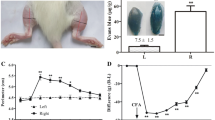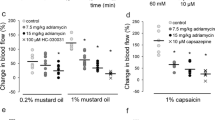Abstract
Recent findings indicate that chemical stimulation of the porcine skin with capsaicin evokes a flare response similar to that observed in man. The aim of the present study was to elucidate whether chemical stimulation of cutaneous capsaicin-sensitive nerve endings with mustard oil produces neurogenic inflammatory reactions in the pig.
The application of mustard oil onto the abdominal skin of domestic pigs resulted in a pronounced flare response. After a previous intravenous injection of a solution of Evans blue, the skin area in contact with the irritant turned dark blue, indicating a marked extravasation of albumin. Quantitative estimation of the dye content of the skin supported this conclusion. The technique of vascular labelling revealed a delicate network of small subepidermal blood vessels in histological preparations after the application of mustard oil following a previous intravenous injection of colloidal silver. Labelled blood vessels were not noted outside the treated area.
The present results show that mustard oil produces a strong cutaneous inflammatory response in the pig, and suggest that the porcine skin provides a valuable model for study of the significance of capsaicinsensitive sensory nerves in vascular and other cutaneous reactions.
Similar content being viewed by others
References
N. Jancsó,Desensitization with capsaicin as a tool for studying the function of pain receptors. InPharmacology of Pain (Ed. R. K. S. Lim) pp. 33–55, Pergamon, Oxford 1968.
G. Jancsó, E. Király and A. Jancsó-Gábor,Pharmacologically induced selective degeneration of chemosensitive primary sensory neurones. Nature270, 741–743 (1977).
G. Jancsó, E. Király and A. Jancsó-Gábor,Chemosensitive pain fibers and inflammation. Int. J. Tiss. Reac.2, 57–66 (1980).
L. A. Chahl,Antidromic vasodilatation and neurogenic inflammation. Pharmacol. Ther.37, 275–300 (1988).
G. Jancsó,Sensory nerves as modulators of inflammatory reactions. InAntidromic Vasodilatation and Neurogenic In-flammation (Eds. L. A. Chahl, J. Szolcsányi and F. Lembeck) pp. 207–222, Akadémiai Kiadó, Budapest 1984.
T. Lewis,The blood vessels of the human skin and their responses. Shaw and Sons, London 1927.
B. Lynn and B. Cotsell,Blood flow increases in the skin of the anaesthetized rat that follow antidromic sensory nerve stimulation and strong mechanical stimulation. Neurosci. Lett.137, 249–252 (1992).
A. N. Bruce,Vaso-dilator axon-reflexes. Q. J. Exp. Physiol.6, 339–354 (1913).
P. Holzer,Local effector functions of capsaicin-sensitive sensory nerve-endings — involvement of tachykinins, calcitonin gene-related peptide and other neuropeptides. Neutoscience24, 739–768 (1988).
P. Holzer,Capsaicin: Cellular targets, mechanisms of action, and selectivity for thin sensory neurons. Pharmacol. Rev.43, 143–201 (1991).
C. A. Maggi and A. Meli,The sensory-efferent function of capsaicin-sensitive sensory neurons. Gen. Pharmacol.19, 1–43 (1988).
G. Jancsó, F. Obál, Jr., I. Tóth-Kása, M. Katona and S. Husz,The modulation of cutaneous inflammatory reactions by peptide-containing sensory nerves. Int. J. Tiss. Reac.7, 449–457 (1985).
G. Jancsó and Z. Janka,A simple test for topographical diagnosis of sensory nervous system lesions. Eur. Neurol.20, 84–87 (1981).
B. Lynn and J. Shakhanbeh,Substance P content of the skin, neurogenic inflammation and numbers of C-fibres following capsaicin application to a cutaneous nerve in the rabbit. Neurosci.24, 769–775 (1988).
Fr.-K. Pierau and J. Szolcsányi,Neurogenic inflammation: Axon reflex in pigs. Agents and Actions26, 231–232 (1989).
P. Kenins,Identification of the unmyelinated sensory nervews which evoke plasma extravasation in response to antidromic stimulation. Neurosci. Lett.25, 137–141 (1981).
L. A. M. Bharali and S. J. W. Lisney,The relationship between unmyelinated afferent type and neurogenic plasma extravasation in normal and reinnervated rat skin. Neuroscience47, 703–712 (1992).
R. Scheuplein,Site variations in diffusion and permeability. InThe physiology and pathophysiology of the skin (Ed. A. Jarrett) pp. 1731–1752, Academic Press, London 1978.
G. Majno, G. E. Palade and G. I. Schoelf,Studies on Inflammation. II. The site of action of histamine and serotonin along the vascular tree: A topographic study. J. Biophys. Biochem. Cytol.11, 607–625 (1961).
K. Alving, R. Matran and J. M. Lundberg,Capsaicininduced local effector responses, autonomic reflexes and sensory neuropeptide depletion in the pig. Naunyn-Schmiedeberg's Arch. Pharmacol.343, 37–45 (1991).
Author information
Authors and Affiliations
Rights and permissions
About this article
Cite this article
Jancsó, G., Pierau, FK. & Sann, H. Mustard oil-induced cutaneous inflammation in the pig. Agents and Actions 39, 31–34 (1993). https://doi.org/10.1007/BF01975711
Received:
Accepted:
Issue Date:
DOI: https://doi.org/10.1007/BF01975711




